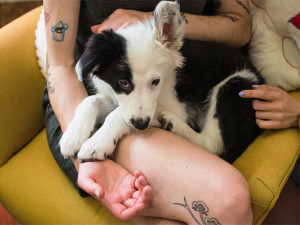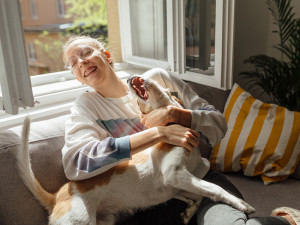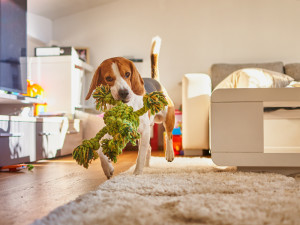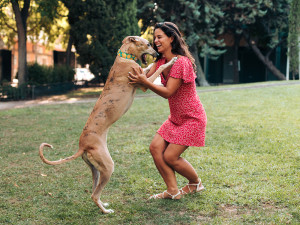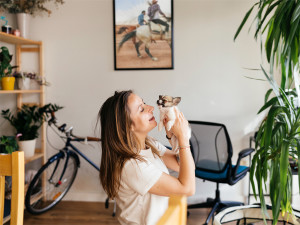You’ve Got Company: How to Cohabitate with a New Dog
Boundaries, right? But if they end up sleeping in bed, that’s cool, too.

Share Article
Sharing space with someone is no small thing. You have no excuse not to pick up after yourself, take the garbage out, and keep the toilet seat down. Sharing your space with a dog is kind of like that, too. As awkward as it feels for you, chances are the feeling’s not only mutual, but even more bewildering for your new pup. New digs. New family. New rules. It’s a lot. Stressing out about your stressed-out dog will get you nowhere. A smooth transition starts with preparation, patience, and structure. Read on for our hard-won wisdom on navigating coupledom with a new dog.
Preparing for their arrival
Any intel you can get ahead of time will help your dog adjust to their new home. For example, veterinarian Dr. Katie Lytle recommends asking about any training already underway. “Find out the dog’s housebreaking status. Especially with a puppy, it’s helpful to know how often they’re going outside,” she says. “If you can’t be home at those times, can you arrange for someone to come and let them out? That consistency will help your dog complete their training effectively, and that will make things easier for everyone.”
Learning what you can about your dog’s temperament and personality will also help you set expectations for how the transition will go. Are you getting a shy dog who may need more alone time, or an outgoing dog who likes to be the center of attention? If you’re adopting from a shelter, Valerie Peck, a certified trainer with the Humane Society for Southwest Washington, recommends asking the adoption coordinator if they have any history on the dog. “The shelter may have information about prior homes or environments where the dog has lived,” she says. “You can also ask questions about the dog’s behavior in the shelter. That doesn’t always reflect how they are going to be in your home but may be a good starting point.”
The first few days
Going to an unfamiliar home can be stressful — for a dog, too. It’s best to keep things low-key at first. Start by introducing your pup to just one room of the house and make that a safe place for them. This will help them feel more comfortable and help you keep an eye on them. And if you can avoid it, don’t leave your dog at home for long periods of time while they get used to their surroundings. “For the first couple of days, have an open mind and don’t put too many expectations on your dog,” Peck recommends. “They tend to sleep a lot, so make sure they have a quiet area or a crate where they can rest if they want to. And give them privacy when they’re eating.”

Also, as much as your friends and family are dying to meet your new dog (and you’re equally dying to show them off), hold off on introducing your pup to their new entourage because, you know, meeting new people can be overwhelming. Peck’s advice: “Limit it to meeting immediate family, playing in the yard, and walking in the neighborhood while your dog decompresses.” Above all, be patient. You and your new dog will need some time to figure each other out. Not everything will go exactly as planned, and that’s okay.
What to expect with a shelter dog
Shelter dogs come from various backgrounds, so the experience of introducing them to a new home is going to vary from dog to dog. However, you can get a sense for how things might go using the handy “Rule of Threes.” Peck explains the math: “The first three days are very overwhelming for dogs. Because it’s a new environment, they may either be shyer or rowdier than usual. After three weeks, they’ll start getting into a routine. At that point, you’ll see more of their personality, and they’ll start to feel like they’re part of the family. After three months, they’ll be pretty settled in, and you can expect to see your dog’s true colors.” The most rewarding part of the journey is witnessing all their “firsts” as they learn to trust: wagging their tail, rolling over for a belly rub, figuring out fetch. Before long, you won’t remember what life was like without them.
Setting boundaries and establishing routines
Dogs like to know what’s expected of them and what to expect from others. In fact, they often find uncertainty stressful. To help them feel at ease in their new environment, establish a set of rules and routines for your dog, and get everyone on board with following them. Is your dog going to be allowed on the couch? Will any rooms be off-limits? Have you thought through the ideal schedule for walks and meals? Dogs are people pleasers at heart, but if the rules change depending on which human is around, your dog will be confused. Everyone in the household should be on the same page.
Getting to know your dog
Figuring out your new pup’s personality and quirks is one of the best parts of being a pet parent. But how do you start building that relationship? “Dogs are social animals,” Dr. Lytle says. “By nature, they’re going to want to be part of the family, but the types of interactions they enjoy will vary. I recommend that every pet parent learn the basics of reading a dog’s body language. That will give you valuable clues into how your dog is feeling in any given situation.”
Finally, try not to compare your new dog to pups you’ve had in the past because every dog is unique. “It’s important to recognize that not every dog is going to be stimulated or enticed by the same things,” Dr. Lytle adds. “If you know your dog’s breed mix, that can help you find activities that align with their natural preferences. Once you find out what motivates your dog, that will unlock opportunities for training and trust-building.” Dogs don’t come with manuals, but building that one-of-a-kind relationship isn’t just part of the experience. It is the experience.

Kate Sheofsky
Kate Sheofsky hails from San Francisco, where she developed a love of writing, Giants baseball, and houses she can’t afford. She currently lives in Portland, OR, and works as a freelance writer and content strategist. When not typing away on her laptop, she enjoys tooling around the city with her two rescue pups searching for tasty food and sunny patios.
Related articles
![girl with blue hair starting puppy training with white dog]()
Puppy Training 101: How to Train a Puppy
You gotta start somewhere.
![woman gives small black dog treat for sitting]()
Your Dog Should Do This 30-Day Training Challenge
It’s like your 30-day yoga challenge — except with way more training treats.
![Portrait of a woman playing and having fun in the park with her big pet, a greyhound dog.]()
How’s Your Dog Feeling? Check Their Tail
If your dog’s tail is wagging “to the left, to the left,” as Beyoncé says, it could mean they’re anxious.
![Two colorful Great Danes illustration.]()
Ever Ask Your Dog “Why Are You Like This?” DNA Is the Answer — Kind Of
This study says it’s actually less about what’s in their DNA and more about what’s on it.
![woman with new puppy]()
9 Unexpected To-Dos for New Pet Parents
Sound advice from seasoned dog and cat parents who have been there.
![Young woman looking at cellphone with her dog]()
Does Your Dog Understand When You FaceTime Them?
It’s a nice thought.

